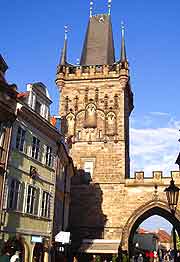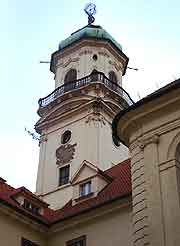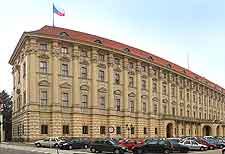Prague History Facts and Timeline
(Prague, Czech Republic)

As the now capital of the Czech Republic, the history of Prague documents its rise to fame and fortune, although its growth wasn't always smooth sailing.
Fortified settlements have existed here, around the Vltava River, for literally thousands of years, dating back to the Paleolithic ages and the time of the Celts. Prague Castle has been very much at the heart of the local community since its creation in 870 AD. This giant landmark now impressively ranks as the largest ancient castle in existence, anywhere in the world, with its epic proportions measuring in at roughly 570 metres / 1,870 feet long by more than 125 metres / 410 feet wide.
Early History of the City
Following the completion of Prague Castle, St. Vitus Cathedral was built within the castle grounds, in 926 AD. Just a few decades later, the city's bishopric was formed, while in the 10th century, the construction of Vysehrad Castle was another major achievement for the city, with this castle located on the Vltava's opposite bank.
In the latter part of the 11th century, King Vratislav I came to the city and soon became an influential resident, helping to elevate the status of the city accordingly. Roughly a century later and during the reign of King Vratislav II, Judita's Bridge (Judith Bridge) was built across the Vltava River out of stone, to replace a previous wooden incarnation that was destroyed by floods in 1157. This bridge was to last for some 170 years, until the floods of 1342. Now ruling over Bohemia, King Charles IV was instrumental in building a replacement and indeed, he even laid the very first foundation stone of the famous Charles Bridge, which is still very much in evidence today.

The City's Rise to Power
By now, Prague had its own Town Hall (the Staromestska Radnice), and its cathedral status was further upgraded to archbishopric. Soon after, the very first university in the whole of Central Europe was to be built in Prague, namely the Charles University (Univerzita Karlova v Praze), which was completed in 1348 and currently boasts a student base in the region of 50,000.
Over the years that followed, Prague witnessed the arrival of the Habsburg monarchy in 1526, and in 1583, King Rudolf II started living here until the end of his reign in 1611. Battles and sieges came and went, including the uprising of the Czech Nobles between the years of 1618 and 1620, the Thirty Years' War from 1618 to 1648, and the Battle of White Mountain in 1620, at nearby Bila Hora.
The Saxon War of 1631 and the Battle of Prague in 1648 resulted in a dramatic drop in the city's population, which fell by some 40,000 to just 20,000. The year of 1698 dealt another blow to Prague, when a catastrophic fire destroyed much of the city, and just three decades later, more than 12,000 people had sadly seen their lives taken at the hands of sweeping plague epidemics. However, by the end of the 18th century, the city's population was close to a very healthy 100,000 inhabitants.
The Czech Aristocracy
After the 1757 Battle of Prague, a number of the locals now living here were extremely wealthy and influential. These included merchants who had made their fortunes from trading, along with powerful noblemen, who commissioned the building of various baroque-style palaces and grand residences, as well as a series of imposing churches. This period in Prague history formed much of the city's present-day character and heritage, and the city began to enjoy its affluence and success.

Expansion and Industry
In 1784, King Joseph II decreed that the municipalities of Hradcany, Malá Strana, Nové Mesto and Stare Mesto would all be amalgamated to form one giant municipality. The districts remain a part of the city, being joined by the Jewish Quarter (Josefov) in 1850.
After the initial merge, the industrial revolution began to transform the city, with factories springing up everywhere and much employment handed out. This was an easy time for Prague, particularly since coal was rather conveniently in abundance close by, along with iron mills.
20th-Century History Onwards
After the First World War resulted in the demise of the empire of Austria-Hungary, a new, independent Czechoslovakia was declared in 1918, with Prague as its capital. By now, many German-speaking people were living here, just as the Second World War came along. Hitler brought his army to the city in 1939 and gave a speech from Prague Castle itself, where he announced his plans for the Protectorate of Bohemia and Moravia (Protektorát Cechy a Morava).
German occupation enveloped the entire country and most Jewish communities were persecuted. More than 1,000 inhabitants of Prague lost their lives during US bombing raids, and some important buildings and factories were destroyed, although the damage was certainly not as extensive as perhaps it could have been.
Another important era was the Velvet Revolution in 1989, where the streets of the city became crowded with people protesting about the power of the Communist Party of Czechoslovakia. In 1993, the new, more democratic Czech Republic was born, with Prague holding its hand as its proud capital.
 As the now capital of the Czech Republic, the history of Prague documents its rise to fame and fortune, although its growth wasn't always smooth sailing.
As the now capital of the Czech Republic, the history of Prague documents its rise to fame and fortune, although its growth wasn't always smooth sailing.
